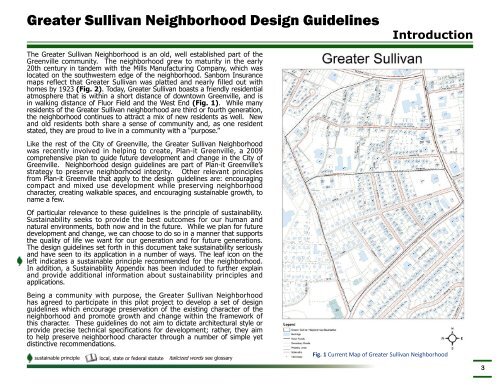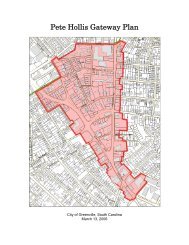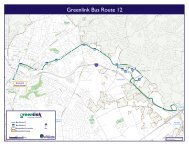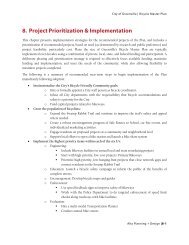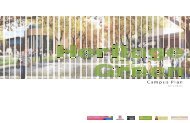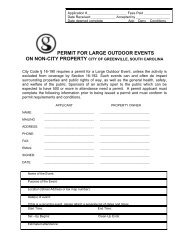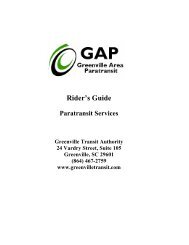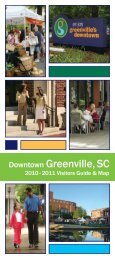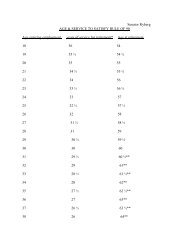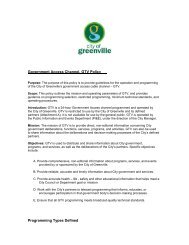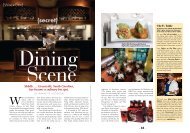Greater Sullivan Neighborhood Design Guidelines - City of Greenville
Greater Sullivan Neighborhood Design Guidelines - City of Greenville
Greater Sullivan Neighborhood Design Guidelines - City of Greenville
Create successful ePaper yourself
Turn your PDF publications into a flip-book with our unique Google optimized e-Paper software.
<strong>Greater</strong> <strong>Sullivan</strong> <strong>Neighborhood</strong> <strong>Design</strong> <strong>Guidelines</strong><br />
Introduction<br />
The <strong>Greater</strong> <strong>Sullivan</strong> <strong>Neighborhood</strong> is an old, well established part <strong>of</strong> the<br />
<strong>Greenville</strong> community. The neighborhood grew to maturity in the early<br />
20th century in tandem with the Mills Manufacturing Company, which was<br />
located on the southwestern edge <strong>of</strong> the neighborhood. Sanborn Insurance<br />
maps reflect that <strong>Greater</strong> <strong>Sullivan</strong> was platted and nearly filled out with<br />
homes by 1923 (Fig. 2). Today, <strong>Greater</strong> <strong>Sullivan</strong> boasts a friendly residential<br />
atmosphere that is within a short distance <strong>of</strong> downtown <strong>Greenville</strong>, and is<br />
in walking distance <strong>of</strong> Fluor Field and the West End (Fig. 1). While many<br />
residents <strong>of</strong> the <strong>Greater</strong> <strong>Sullivan</strong> neighborhood are third or fourth generation,<br />
the neighborhood continues to attract a mix <strong>of</strong> new residents as well. New<br />
and old residents both share a sense <strong>of</strong> community and, as one resident<br />
stated, they are proud to live in a community with a “purpose.”<br />
Like the rest <strong>of</strong> the <strong>City</strong> <strong>of</strong> <strong>Greenville</strong>, the <strong>Greater</strong> <strong>Sullivan</strong> <strong>Neighborhood</strong><br />
was recently involved in helping to create, Plan-it <strong>Greenville</strong>, a 2009<br />
comprehensive plan to guide future development and change in the <strong>City</strong> <strong>of</strong><br />
<strong>Greenville</strong>. <strong>Neighborhood</strong> design guidelines are part <strong>of</strong> Plan-it <strong>Greenville</strong>’s<br />
strategy to preserve neighborhood integrity. Other relevant principles<br />
from Plan-it <strong>Greenville</strong> that apply to the design guidelines are: encouraging<br />
compact and mixed use development while preserving neighborhood<br />
character, creating walkable spaces, and encouraging sustainable growth, to<br />
name a few.<br />
Of particular relevance to these guidelines is the principle <strong>of</strong> sustainability.<br />
Sustainability seeks to provide the best outcomes for our human and<br />
natural environments, both now and in the future. While we plan for future<br />
development and change, we can choose to do so in a manner that supports<br />
the quality <strong>of</strong> life we want for our generation and for future generations.<br />
The design guidelines set forth in this document take sustainability seriously<br />
and have seen to its application in a number <strong>of</strong> ways. The leaf icon on the<br />
left indicates a sustainable principle recommended for the neighborhood.<br />
In addition, a Sustainability Appendix has been included to further explain<br />
and provide additional information about sustainability principles and<br />
applications.<br />
Being a community with purpose, the <strong>Greater</strong> <strong>Sullivan</strong> <strong>Neighborhood</strong><br />
has agreed to participate in this pilot project to develop a set <strong>of</strong> design<br />
guidelines which encourage preservation <strong>of</strong> the existing character <strong>of</strong> the<br />
neighborhood and promote growth and change within the framework <strong>of</strong><br />
this character. These guidelines do not aim to dictate architectural style or<br />
provide precise technical specifications for development; rather, they aim<br />
to help preserve neighborhood character through a number <strong>of</strong> simple yet<br />
distinctive recommendations.<br />
sustainable principle local, state or federal statute italicized words see glossary<br />
Fig. 1 Current Map <strong>of</strong> <strong>Greater</strong> <strong>Sullivan</strong> <strong>Neighborhood</strong><br />
3


